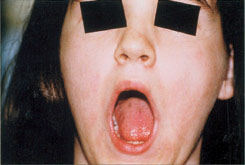
 |
| Figure 1: Luxation of the temporomandibular joint in a 12-year-old patient. |
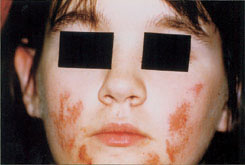 |
| Figure 2: Bilateral bleeding in the cheeks following episodes of luxation. |
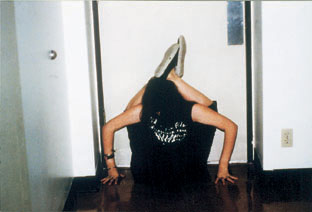 |
| Figure 3: Unusual body posture demonstrating joint hypermobility. |
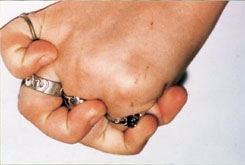 |
| Figure 4: Hyperextension and hyperabduction of the fingers. |
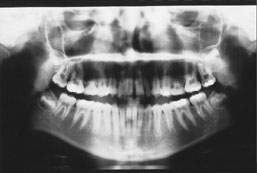 |
| Figure 5: A panoramic radiograph demonstrating the absence of 2 maxillary premolars. |
Table
1
Classification
of Ehlers-Danlos syndrome
Type
|
Transmission |
Clinical Features |
Biochemical
Defects
|
% of Cases |
|
I – Severe or
classic |
ADa |
Skin hyperelasticity and fragility Dystrophic scars Joint hypermobility Abnormal bleeding tendency |
Unknown |
80% |
|
II – Moderate |
AD |
Symptoms less pronounced than in type I |
Unknown |
|
|
III – Familial
hypermobility |
AD |
Joint hypermobility Multiple dislocations Skin hyperelasticity Absence of dystrophic scars Normal coagulation |
Unknown |
10% |
|
IV – Vascular
(Sack-Barabas) A, B, C, D |
AD (A, B, C) ARb (D) |
Vascular fragility (arterial rupture) Moderate hypermobility of the finger joints Perforation of certain hollow organs (uterus, intestine) |
Deficit of collagen type III |
4% |
|
V – Chromosome
X linked |
XLc |
Similar to types II and III |
Unknown |
»
6%d |
|
VI – Ocular A,
B |
AR (A, B) |
Hyperelasticity of the skin Joint hypermobility Detached retina Severe scoliosis |
Lysyl hydroxylase deficiency |
|
|
VII –
Arthrochalasis multiplex
congenita A, B, C |
AD (A, B) AR (C) |
Congenital luxation of the hips Multiple joint dislocations Moderate hyperelasticity of the skin Small stature |
A - Faulty pro-alpha 1 structure B - Faulty pro-alpha 2 structure C - Procollagen n-proteinase deficiency |
|
|
VIII –
Periodontal |
AD |
Generalized early-onset periodontitis Moderate joint hypermobility Variable skin hyperelasticity Shin ecchymoses |
Unknown |
aAD Autsomal
dominant
bAR
Autosomal recessive
cXL
Chromosome X linked
dApproximate
% including all other types (V - XI, Hernandez, Friedman-Harrod, Beasley-Cohen,
Viljoen)
Table
2
Clinical
manifestations of Ehler-Danlos syndrome
Examination |
Clinical
Signs |
Complications |
|
Extraoral |
Scarring
of the forehead and chin Hypertelorism
and epicanthus Narrow
curved nose Thin
hair Deformed
ears |
Frequent
luxations and subluxations of the TMJ Hyperelasticity
of the skin |
|
Intraoral
(soft tissues) |
Supple
tongue Gingival
hyperplasia and fibrous nodules21 |
Buccal
mucosa:
Fragility
Reduced healing capacity
Bruising tendency Periodontal
tissues: Bleeding after
brushing
Vulnerable to gingivitis and periodontal disease
Excessive post-extraction bleeding |
|
Intraoral
(hard tissues) |
Vaulted
palate Deep
fissures and long cusps Microdontia
Supernumeraries22 Pulp
calcification Abnormal
roots |
Teeth:
Fragility
Tendency to fracture |